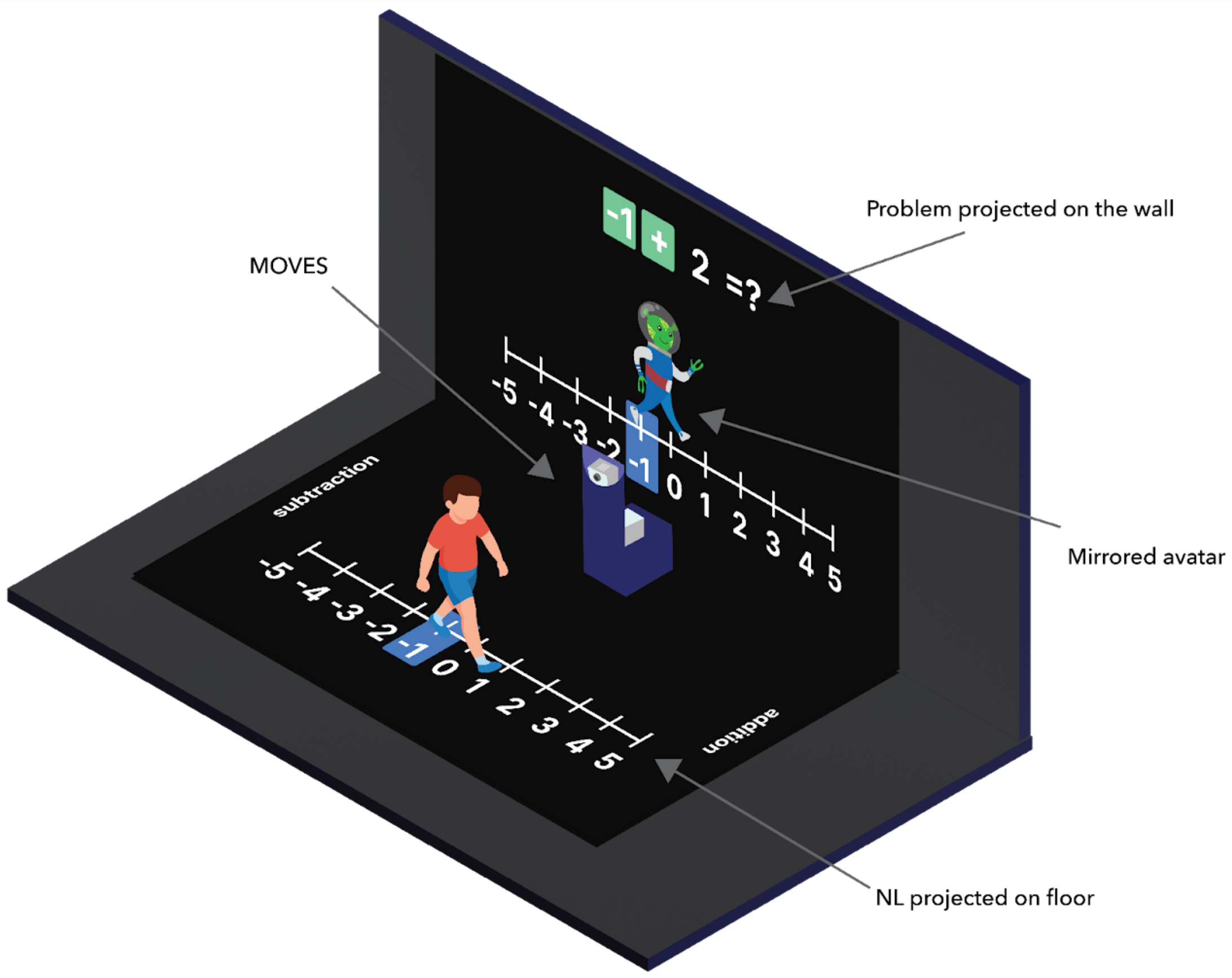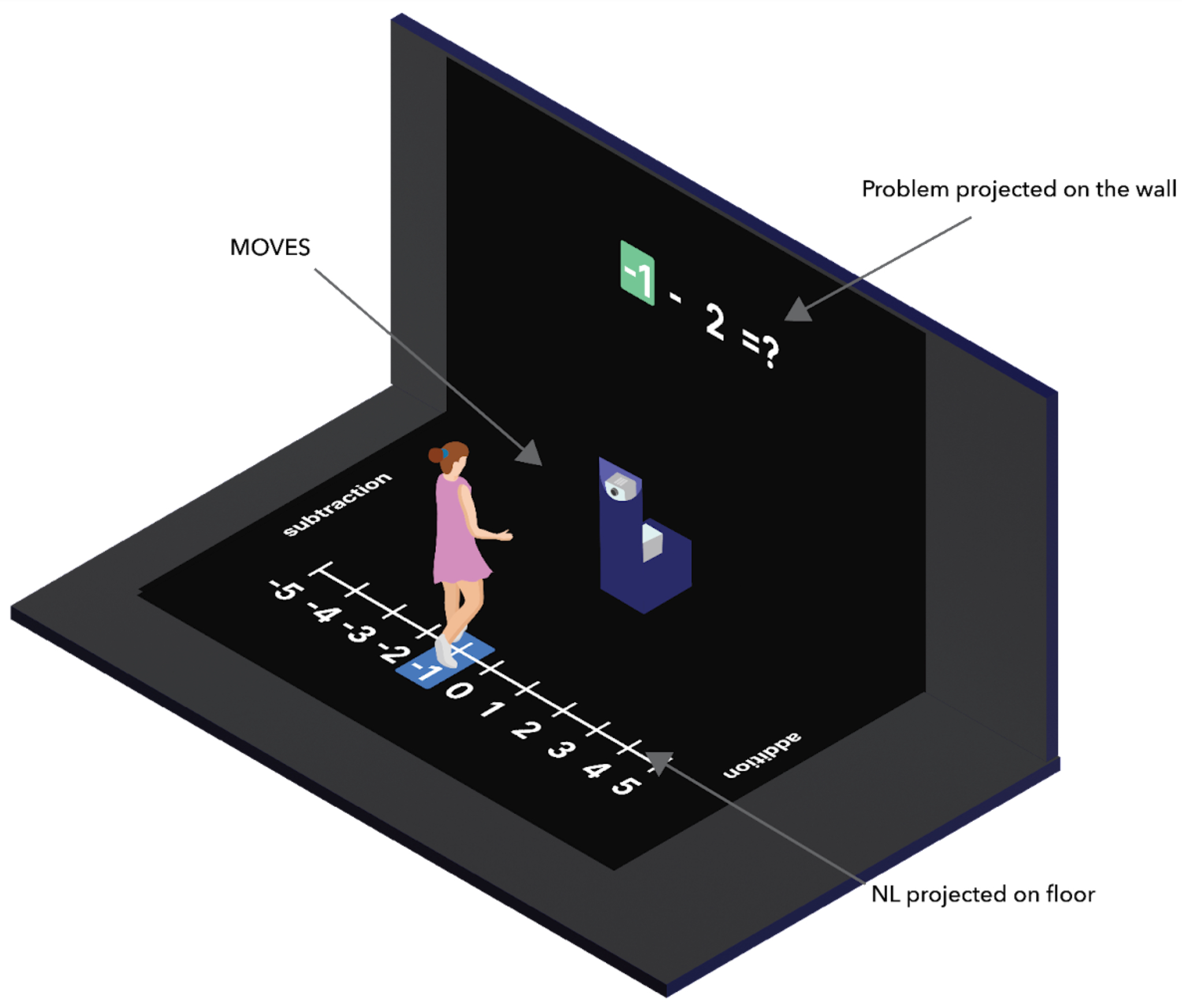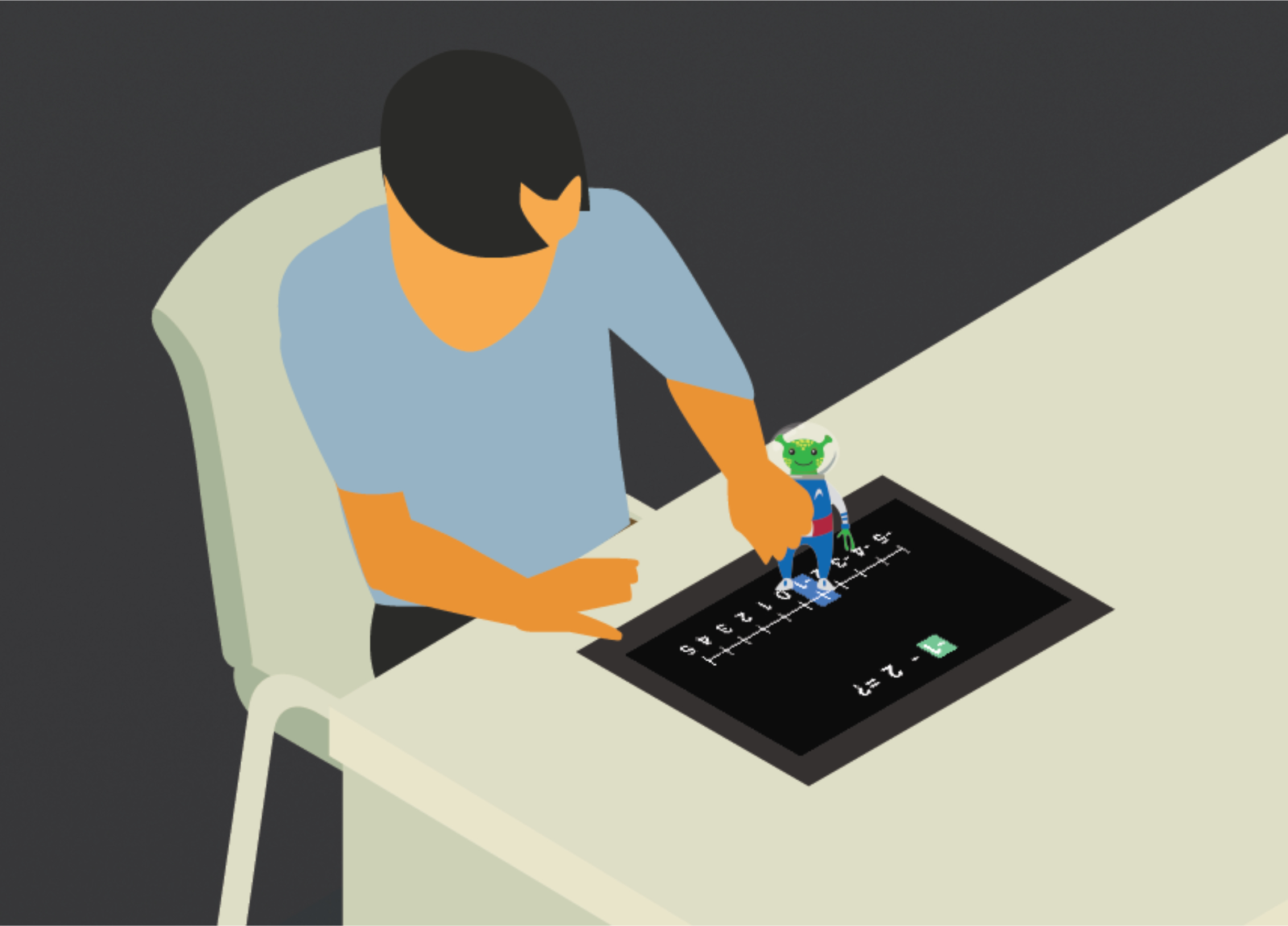Project team: Jacqueline Anton (Berkeley School of Education, UC Berkeley; Special Education, SFSU); Giulia Cosentino (Norwegian University of Science and Technology); Mirko Gelsomini (Politecnico di Milano); Dor Abrahamson (Graduate School of Education, UC Berkeley)
Acknowledgement: The Peder Sather Center for Advanced Study Grant Program for collaboration between the University of California Berkeley and Norway universities
Rationale
Early mathematics education presents elementary-school students with the challenge of adding and subtracting negative integers. In elementary school, students develop number sense through their interaction with the world around them. For example, counting fingers, toys, and other concrete objects enables children to develop a sense of the value, cardinality, and order of integers. However, students often struggle to perform operations involving negative values.
Embodied designs (such as the walking number line) typically allow for students to enact problems from an egocentric perspective. In an egocentric perspective, objects and actions are described with respect to one’s own body, while in an allocentric perspective, objects are described with respect to other objects.. Students who use their whole body to move and learn in new ways experience action egocentrically, and are not often required to coordinate this perspective with an allocentric one. However, ultimately students are required to adopt an allocentric perspective in utilizing standard materials, such as paper and pencil. Therefore, students need to be able to coordinate their egocentric experience on a large number line (NL) with an allocentric experience on a small, paper NL in order to be successful in classroom mathematics.
Design
First, students solve basic addition and subtraction problems on a body-scale walking NL, so that they might enact the process of adding and subtracting integers by engaging in whole-body movement. See below for teachers’ instruction and students’ actions with the four basic moves of adding or subtracting positive or negative numbers on the body-scale NL.
Figure 1
Walking NL (egocentric perspective)
After several sessions of solving integer arithmetic problems by walking the NL, students simulate their full-body actions by manipulating a “mini-me” figure on a desk-scale NL (allocentric orientation). Note that whereas the figurine is reenacting an egocentric experience scaled down from the student’s prior experience walking the NL, the student who is now puppeteering the figurine sees the NL from an allocentric perspective. We conjecture that this bi-perspectival activity configuration will support students in coordinating the two perspectives, so that they can ground a normative allocentric use of the standard NL in their egocentric experience walking the body-scale NL.
Figure 2
Desk-Scale Number Line (allocentric perspective)
The Technology
This educational design utilizes MOVES, a portable MSE system consisting of two projectors, a motion-sensing camera, and a mini PC, to create three different NL-based interactions. The first interaction (Figure 3) includes a NL ranging from –5 to +5 projected onto the floor along with either an addition or a subtraction problem projected onto the wall. The dual wall-and-floor projectors are coordinated through the SENSEi software (Gelsomini, 2023), which allows the motion sensor to track students’ position, orientation, and movement on the NL and, in response, mark the current position dynamically on the floor projection. In particular, when students stand on each hash mark along the NL, the number under their feet turns blue and a pleasant chime is sounded. This way, students can see and hear that the motion sensor is capturing their position. SENSEi’s interactive sonification affordances are particularly important for blind and visually impaired student accessibility, albeit the current paper will not elaborate on the potential inclusivity parameters of future variants on MOVES-NL that will cater to sensorimotor diverse students.
Figure 3
Walking NL as projected by MOVES
In addition to recognizing student position on the NL, the projector registers student orientation and movement. As the student performs the correct movements, the problem on the wall lights up in green and a congratulatory sound is played, providing students with in-the-moment feedback on their whole body movements. For example, given the problem “ – 1 – 2,” the student would first stand on the NL’s -1 hash mark. As they do so, the -1 on the floor-projected NL lights up in blue, and a chime is played. Concurrently, the -1 on the wall-projected NL in front of the student lights up in green. Next, the student needs to turn to the left, in order to orient themselves in the subtraction direction (still before moving). As soon as the student turns left, the subtraction sign on the wall turns green. Finally, the student needs to take 2 steps forward (i.e., in the direction they are facing, which is toward the lesser values on the NL). Once the student has taken the 2 steps, they raise their hands in the air to signal that they have reached the solution. If the solution is correct, the entire problem on the wall is highlighted in green, a congratulatory sound plays, and the solution is displayed.
The second interaction is largely the same as the first, only that a virtual avatar projected onto the wall mirrors the students’ position and movements on the walking NL. See Figure 3 for an illustration of the second interaction.
Figure 4
Walking NL as projected by MOVES with the mirrored avatar functionality activated
 Here, the student receives the same feedback from the motion sensor as in the floor-only earlier activity. In addition, however, the avatar projected onto the wall mimics student movement. The design rationale of deploying a mirrored avatar in full view of the student is to support the student in bridging the egocentric experience of walking along the NL with the allocentric experience that is required in the final interaction, when the student is seated at a desk.
Here, the student receives the same feedback from the motion sensor as in the floor-only earlier activity. In addition, however, the avatar projected onto the wall mimics student movement. The design rationale of deploying a mirrored avatar in full view of the student is to support the student in bridging the egocentric experience of walking along the NL with the allocentric experience that is required in the final interaction, when the student is seated at a desk.
The third and final interaction involves only a tablet, which displays a smaller, desk-scale NL and, again, presents an addition or subtraction problem (see Figure 5). During this interaction, the student reenacts their previous whole-body movements by moving a tangible figurine (of identical appearance as the virtual avatar) along the small NL, just as they had moved their whole bodies on the walking NL.
Figure 5
Student moving a tangible figurine on the tablet NL
References
Anton, J., & Abrahamson, D. (2025). Walking the number line: Towards an enactive understanding of integer arithmetic. Instructional Science, 53, 657–677. https://doi.org/10.1007/s11251-025-09707-w
Anton, J., Cosentino, G., Sharma, K., Gelsomini, M., Mok, M., Giannakos, M., & Abrahamson, D. (2025). The human condition: Modal and interactive advantages of teacher over AI feedback on children’s mathematical performance. In M. Fan, M. Horn, & M. Roussou (Eds.), Proceedings of the annual meeting of ACM SIG Interaction Design and Children (IDC 2025). ACM. 183-203. https://doi.org/10.1145/3713043.3728863
Cosentino, G., Anton, J., Gelsomini, M., Sharma, K., Giannakos, M. N., & Abrahamson, D. (2025). Generative AI and multimodal data for educational feedback: Insights from embodied math learning. In L. Yan, V. Pammer-Schindler, C. Mills, A. Nguyen, & D. Gasevic (Eds.), Empirical studies on the impact of generative AI on learning <Special issue>. British Journal of Educational Technology, 00, 1–24. https://doi.org/10.1111/bjet.13587
Cosentino, G., Anton, J., Sharma, K., Gelsomini, M., Giannakos, M., & Abrahamson, D. (2025). Exploring children’s embodied interactions through digitally facilitated enactment: A case study when math education MOVES. International Journal of Human-Computer Studies, 201, 103509. https://doi.org/10.1016/j.ijhcs.2025.103509
Cosentino, G., Anton, J., Sharma, K., Gelsomini, M., Giannakos, M., & Abrahamson, D. (2024). Hybrid teaching intelligence: Lessons learned from an embodied mathematics learning experience. In S. Järvelä, G. Zhao, A. Nguyen, & H. Chen (Eds.), Hybrid intelligence: human-AI co-evolution and learning <Special issue>. British Journal of Educational Technology, 00, 1–29. https://doi.org/10.1111/bjet.13525
Anton, J., Cosentino, G., Gelsomini, M., Sharma, K., Giannakos, M., & Abrahamson, D. (2024). Mathematics MOVES me: Digital solutions for coordinating enactive and symbolic perspectives—The case of positive and negative integers arithmetic <Snapshot>. Digital Experiences in Mathematics Education, 11, 262–275. https://doi.org/10.1007/s40751-024-00158-5
Anton, J. (2024, April). Walking the number line: Towards an enactive understanding of integer arithmetic. In D. Abrahamson (Chair) & S. Gerofsky (Discussant), In-sight out: Challenges and opportunities in learning mathematics through negotiating egocentric and allocentric perspectives. Symposium presented for the SIG Research in Mathematics Education at the annual meeting of the American Educational Research Association, Philadelphia, April 11–14.
Anton, J. (2024, April). Building an enactive understanding of the number line. In Intersections across STEM Learning Environments <Structured poster session>. Poster presented at the annual meeting of the American Educational Research Association, Philadelphia, April 11–14.
Cosentino, G., & Anton, J.(2023, November). MOVES- number line: Digital solutions for coordinating enactive and symbolic perspectives- the case of basic arithmetic with positive and negative integers. Invited colloquium talk, Graduate Group in Science and Mathematics Education (SESAME) Colloquium, University of California Berkeley, California, United States, November 9, 2023.
Anton, J. (2023, June). Walking the number line: Towards an enactive understanding of integer arithmetic <Presentation>. American Association on Intellectual and Developmental Disabilities 147th annual meeting, Pittsburgh, PA, United States.
Anton, J. (2023). Walking the number line: Enactive understanding of integer arithmetic. Poster prepared for Research Day, Graduate School of Education, University of California, Berkeley.



